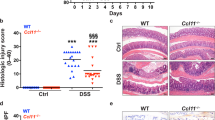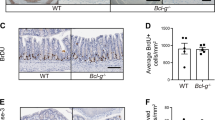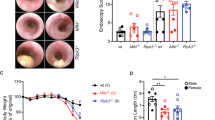Abstract
Carcinoembryonic antigen-related cell adhesion molecule 1 (CEACAM1) is a glycoprotein that is part of the carcinoembryonic antigen and the immunoglobulin superfamilies. We have shown that it functions as a tumor suppressor and that this function depends upon the presence of the longer CEACAM1 cytoplasmic domain. In this report, we describe the generation of a Ceacam1−/− mouse. The Ceacam1−/− colon exhibits increased in vivo proliferation relative to the wild-type counterpart with a corresponding decreased expression of the p21Cip1 and p27Kip1 Cyclin D kinase inhibitors. The colonic villi undergo decreased apoptosis. Out of 35 litters of mice, no spontaneous tumors in any tissues normally expressing CEACAM1 were found over the lifespan of the animals, suggesting that CEACAM1 may not be involved in initiation of tumor development. However, when mice are treated with azoxymethane to induce colonic tumors, we find that Ceacam1−/− mice developed a significantly greater number of tumors than their littermate controls. Moreover, the tumor size was greater in the knockout mice relative to that in the wild-type mice. These results indicate that deletion of CEACAM1 favors progression of colon tumorigenesis.
This is a preview of subscription content, access via your institution
Access options
Subscribe to this journal
Receive 50 print issues and online access
$259.00 per year
only $5.18 per issue
Buy this article
- Purchase on Springer Link
- Instant access to full article PDF
Prices may be subject to local taxes which are calculated during checkout





Similar content being viewed by others
References
Bamberger AM, Riethdorf L, Nollau P, Naumann M, Erdmann I, Gotze J et al. (1998). Am J Pathol 152: 1401–1406.
Beauchemin N, Draber P, Dveksler G, Gold P, Gray-Owen S, Grunert F et al. (1999). Exp Cell Res 252: 243–249.
Blau DM, Turbide C, Tremblay M, Olson M, Letourneau S, Michaliszyn E et al. (2001). J Virol 75: 8173–8186.
Brabletz T, Jung A, Kirshner T . (2002). Virchows Arch 441: 1–11.
Buckhaults P, Rago C, St Croix B, Romans KE, Saha S, Zhang L et al. (2001). Cancer Res 61: 6996–7001.
Busch C, Hanssen TA, Wagener C, Obrink B . (2002). Hum Pathol 33: 290–298.
Chan CH, Stanners CP . (2004). Mol Ther 9: 775–785.
Cheung PH, Luo W, Qiu Y, Zhang X, Early K, Millirons P et al. (1993). J Biol Chem 268: 24303–24310.
Cournoyer D, Beauchemin N, Boucher D, Benchimol S, Fuks A, Stanners CP . (1988). Cancer Res 48: 3153–3157.
Deschenes C, Vézina A, Beaulieu JF, Rivard N . (2001). Gastroenterol 120: 423–438.
Eberhard A, Kahlert S, Goede V, Hemmerlein B, Plate KH, Augustin HG . (2000). Cancer Res 60: 1388–1393.
Ergün S, Kilic N, Ziegeler G, Hansen A, Nollau P, Götze J et al. (2000). Mol Cell 5: 311–320.
Estrera VT, Chen DT, Luo W, Hixson DC, Lin SH . (2001). J Biol Chem 276: 15547–15553.
Fearon ER, Vogelstein B . (1990). Cell 61: 759–767.
Fodde R, Edelman W, Yang K, van Leewen C, Carlson C, Renault B et al. (1994). Proc Natl Acad Sci USA 91: 8969–8973.
Fodde R, Smits R, Clevers H . (2001). Nat Rev Cancer 1: 55–67.
Fournès B, Sadekova S, Turbide C, Létourneau S, Beauchemin N . (2001). Oncogene 20: 219–230.
Frangsmyr L, Baranov V, Hammarstrom S . (1999). Tumour Biol 20: 277–292.
Gold P, Freedman SO . (1965). J Exp Med 122: 467–481.
Hemmila E, Turbide C, Olson M, Jothy S, Holmes KV, Beauchemin N . (2004). J Virol 78: 10156–10165.
Hixson DC, McEntire KD, Obrink B . (1985). Cancer Res 45: 3742–3749.
Horst AK, Ito WD, Dabelstein J, Schumacher U, Sander H, Turbide C et al. (2006). J Clin Invest (in Press).
Hsieh J-T, Luo W, Song W, Wang Y, Kleinerman DI, Van NT et al. (1995). Cancer Res 55: 190–197.
Huang J, Simpson JF, Glackin C, Riethorf L, Wagener C, Shively JE . (1998). Anticancer Res 18: 3203–3212.
Huber M, Izzi L, Grondin P, Houde C, Kunath T, Veillette A et al. (1999). J Biol Chem 274: 335–344.
Ilantzis C, Jothy S, Alpert LC, Draber P, Stanners CP . (1997). Lab Invest 76: 703–716.
Izzi L, Turbide C, Houde C, Kunath T, Beauchemin N . (1999). Oncogene 18: 5563–5572.
Jantscheff P, Terracciano L, Lowy A, Glatz-Krieger K, Grunert F, Micheel B et al. (2003). J Clin Oncol 21: 3638–3646.
Kinugasa T, Kuroki M, Takeo H, Matsuo Y, Ohshima K, Yamashita Y et al. (1998). Cancer Res 76: 148–153.
Kinzler K, Vogelstein B . (1996). Cell 87: 159–170.
Kleinerman DI, Dinney CP, Zhang WW, Lin SH, Van NT, Hsieh JT . (1996). Cancer Res 56: 3431–3435.
Kleinerman DI, Troncoso P, Lin S-H, Pisters LL, Sherwood ER, Brooks T et al. (1995). Cancer Res 55: 1215–1220.
Kunath T, Ordonez-Garcia C, Turbide C, Beauchemin N . (1995). Oncogene 11: 2375–2382.
Laack E, Nikbakht H, Peters A, Kugler C, Jasiewicz Y, Edler L et al. (2002). J Clin Oncol 20: 4279–4284.
Luo W, Wood CG, Early K, Hung MC, Lin SH . (1997). Oncogene 14: 1697–1704.
Maltzman R, Whittington J, Driggers L, Stephens J, Ahnen D . (1997). Carcinogenesis 18: 2435–2439.
Muenzner P, Dehio C, Fujiwara T, Achtman M, Meyer TF, Gray-Owen SD . (2000). Infect Immun 68: 3601–3607.
Muller MM, Singer BB, Klaile E, Obrink B, Lucka L . (2005). Blood 105: 3925–3934.
Nédellec P, Turbide C, Beauchemin N . (1995). Eur J Biochem 231: 104–114.
Neumaier M, Paululat S, Chan A, Matthaes P, Wagener C . (1993). Proc Natl Acad Sci USA 90: 10744–10748.
Nittka S, Gunther J, Ebisch C, Erbersdobler A, Neumaier M . (2004). Oncogene 23: 9306–9313.
Nollau P, Prall F, Helmchen U, Wagener C, Neumaier M . (1997a). Am J Pathol 151: 521–530.
Nollau P, Scheller H, Kona-Horstmann M, Rohde S, Hagenmuller F, Wagener C et al. (1997b). Cancer Res 57: 2354–2357.
Notterman DA, Alon U, Sierk AJ, Levine AJ . (2001). Cancer Res 61: 3124–3130.
Okamotu M, Ohtsu H, Kominami R, Yonekawa H . (1995). Carcinogenesis 16: 2659–2666.
Oliveira-Ferrer L, Tilki D, Ziegeler G, Hauschild J, Loges S, Irmak S et al. (2004). Cancer Res 64: 8932–8938.
Olsen A, Teglund S, Nelson D, Gordon L, Copeland A, Georgescu A et al. (1994). Genomics 23: 659–668.
Papanikolaou A, Wang Q-S, Delker DA, Rosenberg DW . (1998). Cancer Lett 130: 29–34.
Phan D, Cheng CJ, Galfione M, Vakar-Lopez F, Tunstead J, Thompson NE et al. (2004). Cancer Res 64: 3072–3078.
Potten CS, Loeffler M . (1990). Development 110: 1001–1020.
Quaroni A, Beaulieu JF . (1997). Gastroenterology 113: 1198–1213.
Ravetch JV, Lasnier LL . (2000). Science 290: 84–89.
Robitaille J, Izzi L, Daniels E, Zelus B, Holmes KV, Beauchemin N . (1999). Eur J Biochem 264: 534–544.
Rosenberg M, Nédellec P, Jothy S, Fleiszer D, Turbide C, Beauchemin N . (1993). Cancer Res 53: 4938–4945.
Scholzel S, Zimmermann W, Schwarzkopf G, Grunert F, Rogaczewski B, Thompson J . (2000). Am J Pathol 156: 595–605.
Singer BB, Scheffrahn I, Obrink B . (2000). Cancer Res 60: 1236–1244.
Singh J, Kelloff GF, Reddy BS . (1997). J Oncol 10: 449–456.
Takahashi M, Nakatsugi S, Sugimura T, Wakabayashi K . (2000). Carcinogenesis 21: 1117–1120.
Tanaka K, Hinoda Y, Takahashi H, Sakamoto H, Nakajima Y, Imai K . (1997). Int J Cancer 74: 15–19.
Thies A, Moll I, Berger J, Wagener C, Brummer J, Schulze HJ et al. (2002). J Clin Oncol 20: 2530–2536.
Turbide C, Kunath T, Daniels E, Beauchemin N . (1997). Cancer Res 57: 2781–2788.
van de Wetering M, Sancho E, Verweij C, de Lau W, Oving I, Hurlstone A et al. (2002). Cell 111: 241–250.
Velcich A, Yang WC, Heyer J, Fragale A, Nicholas C, Viani S et al. (2002). Science 295: 1726–1729.
Vivona AA, Shpitz B, Medline A, Bruce WR, Hay K, Ward MA et al. (1993). Carcinogenesis 14: 1777–1781.
Volpert O, Luo W, Liu TJ, Estrera VT, Logothetis C, Lin SH . (2002). J Biol Chem 277: 35696–35702.
Wang QS, Papanikolaou A, Nambiar PR, Rosenberg DW . (2000). Mol Carcinogenesis 28: 139–147.
Wang Q-S, Papanikolaou A, Sabourin CLK, Rosenberg DW . (1998). Carcinogenesis 19: 2001–2006.
Wong ACC, Lo ESF, Lee KC, Chan JKC, Hsiao WLW . (2004). Clin Cancer Res 10: 1401–1408.
Zhang L, Zhou W, Velculescu VE, Kern SE, Hruban RH, Hamilton SR et al. (1997). Science 276: 1268–1272.
Acknowledgements
The authors thank the personnel of the McGill Animal Care Facility for their help. We are also greatly indebted to Dr John Greiner (NIH) and Dr Rajana Bird (University of Manitoba) for discussions on the use of the azoxymethane carcinogen. The authors also wish to thank Ms Anne-Marie Charbonneau Allard and Melina Marlis for their contribution. The research was funded by the Canadian Institutes for Health Research and the Canadian Cancer Society. Nelly Leung received studentships from Canderel, the McGill University Health Center Research Foundation and the Faculty of Medicine studentship programs. Nicole Beauchemin is a senior scholar of the Fonds de Recherche en Santé du Québec.
Author information
Authors and Affiliations
Corresponding author
Additional information
Supplementary Information accompanies the paper on Oncogene website (http://www.nature.com/onc)
Supplementary information
Rights and permissions
About this article
Cite this article
Leung, N., Turbide, C., Olson, M. et al. Deletion of the carcinoembryonic antigen-related cell adhesion molecule 1 (Ceacam1) gene contributes to colon tumor progression in a murine model of carcinogenesis. Oncogene 25, 5527–5536 (2006). https://doi.org/10.1038/sj.onc.1209541
Received:
Revised:
Accepted:
Published:
Issue Date:
DOI: https://doi.org/10.1038/sj.onc.1209541
Keywords
This article is cited by
-
New Checkpoint Inhibitors on the Road: Targeting TIM-3 in Solid Tumors
Current Oncology Reports (2022)
-
TIM3 comes of age as an inhibitory receptor
Nature Reviews Immunology (2020)
-
Visualization of endothelial barrier damage prior to formation of atherosclerotic plaques
Histochemistry and Cell Biology (2017)
-
Loss of CEACAM1, a Tumor-Associated Factor, Attenuates Post-infarction Cardiac Remodeling by Inhibiting Apoptosis
Scientific Reports (2016)
-
The role of CEA-related cell adhesion molecule-1 (CEACAM1) in vascular homeostasis
Histochemistry and Cell Biology (2016)



